Wood Apple (Kapittha) Uses, Research, Remedies, Side Effects
Kapittha (wood apple) is an Ayurvedic plant, used for the treatment of nausea, vomiting, acts as antidote against some poisons, improves the taste perception, beneficial for cardiac muscles, clears the phlegm from the throat, dyspnea and thirst.
Latin name- Feronia limonia Linn., Limonia acidissima
Family- Rutaceae
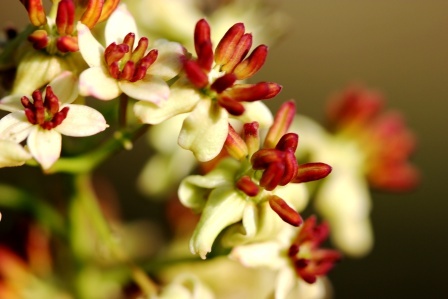
Table of Contents
Vernacular names
Kaitha – Names in different languages:
Hindi name: Beli, Katbhel, Kaitha,
English name: Wood apple, Elephant apple, Organic limonia, Kaitha
Bengali name- Katbhel
Gujarati name- Kotha
Kannada name: Kadu nimbe, Belada hannu
Malayalam name: Cheru kattunarakam, Vilankai
Marathi name: Kavath, Kauth
Tamil name: Vilaa, Vizhaangai
Telugu name: Kapitthamu, Parupuvelaga
Sanskrit synonyms
Sanskrit Synonyms of Kapitta:
Kapi priya- Fruit is liked by the monkeys in the forest
Gandha phala- The ripened fruit has pleasant smell
Vritta phala- The fruit is round in shape
Danta Shata – the sour fruits cause tingling sensation in teeth
Dadhiphala, Dadittha, Takrasthita – The fruit juice is mixed with milk to form curd
Surabhichada, Akshi Sasya, Grahi, Grahi Phala,
Hrudya – good for heart
Kashaya Amrala Phala – sour, astringent fruit
Chirapaki – takes a long time to undergo digestion
Kapeeshta, Kapi Pirya – loved by monkeys.
Aksha Sasya, Malura, Maloora,
Mangalya – auspicious fruit, liked by God Ganesha
Neela Mallika
Granthi Phala – fruit pulp is granular
Karabha Vallabha – liked by elephants. Hence the name Elephant apple
Vrutta Phala – spherical fruits
Karanda Phala, Kathina Phala – hard fruit
Morphology
Morphology of Feronia limonia:
The slow-growing tree is erect, with a few upward-reaching branches bending outward near the summit where they are subdivided into slender branchlets drooping at the tips. The bark is ridged, fissured and scaly and there are sharp spines:3/4 to 2 inches (2-5 cm) long on some of the zigzag twigs. The deciduous, alternate leaves, 3 to 5 inches (7.5-12.5 cm) long, dark-green, leathery, often minutely toothed, blunt or notched at the apex, are dotted with oil glands and slightly lemon-scented when crushed. Dull-red or greenish flowers to 1/2 inch (1.25 cm) wide are borne in small, loose, terminal or lateral panicles. They are usually bisexual. The fruit is round to oval, 2 to 5 inch (5-12.5 cm) wide, with a hard, woody, grayish-white, scurfy rind about 1/4 inch (6 mm) thick. The pulp is brown, mealy, odorous, resinous, astringent, acid or sweetish, with numerous small, white seeds scattered through it.
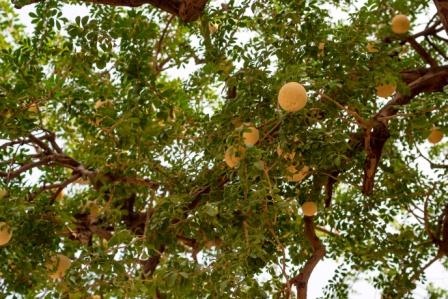
The wood-apple is native and common in the wild in dry plains of India and Ceylon and cultivated along roads and edges of fields and occasionally in orchards.
Properties, part used, dosage
Properties of Ripened fruit:
Rasa (Taste) – Madhura (Sweet), Amla (Sour)
Guna (Qualities) – Guru (Heavy for digestion), Snigdha (Slimy in nature)
Vipaka – Madhura (Undergoes sweet taste after digestion)
Veerya (Potency) – Sheeta (Cold)
Karma (Actions) – Vatapitta shamaka (reduces vitiated vata and pitta dosha)
Unripe fruit –
Balances Kapha Dosha
Increases Vata and Pitta Dosha
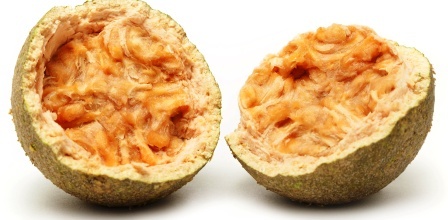
Part used- Fruit, Flower, Root
Dosage-
Flower powder- 5 to 10 g
Juice- 40 to 50 ml
According to Bhojana Kutuhalam 14th chapter, Properties of kapittha in general-
Rasa (Taste) – Sweet, Sour, Astringent, Bitter
Veerya (Potency) – Cold
Effect On Dosha – Alleviates Pitta and Vata
Sagrahi – Absorbent
Vrnanasha – Heals Wound
Unripe Kapittha is sour in taste, hot in potency, helps in treating kantagata rogas(throat related disorders), acts as grahi and aggravates vata dosha.
The ripened kapittha alleviates all the three doshas, has sweet and sour taste, is heavy to digest and the flower of kapittha is said to treat rodent poisoning.
Chemical composition
Chemical composition of Limonia acidissima:
The leaves and stem bark contain the coumarins, luvangetin, xanthotoxin and limonin and the steroids, sitosterol and sitosterol-O-beta-D-glucoside.
Uses
Uses of kapittha (Kaitha – wood apple)
- Fresh juice of the unripe fruit of Kapittha is given in a dose of 15-20 ml to improve the taste, treat anorexia and improve the appetite.
- Fresh juice of ripened fruit or ripened fruit is consumed to treat thirst and improve the body strength.
- The paste of Feronia limonia flower is given in a dose of 5-10 g to treat rat bite poison patients.
- Regular intake of the fresh fruit of Kapittha is consumed regularly to improve the strength of cardiac muscles and cardiac output.
- The juice of fruit of Feronia limonia is given in a dose of 30-50 ml to treat cough and dyspnea. It removes the phlegm from the throat.
- Paste of the root of Feronia limonia is applied over the wounds for quicker healing.
Sanskrit verse
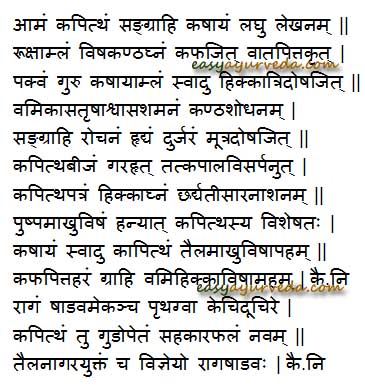
Benefits, Indications
Unripe Elephant apple fruit:
Sangrahi – absorbent, useful in diarrhea, IBS
Kashaya – astringent
Laghu – light to digest
Lekhana – has scraping property, useful in balancing Kapha, in respiratory disorders and in cholesterol / clot deposition in blood vessels
Rooksha – dry
Vishaghna – anti toxic
Kanthaghna – decreases voice
Balances Kapha Dosha
Increases Vata and Pitta Dosha
Ripe Wood apple fruit:
Guru – heavy to digest
Kashaya – astringent
Amla – sour
Svadu – sweet
Hikka – relieves hiccups
Tridoshajit – Balances all the three Doshas
Kanthashodhana – cleanses throat, useful in soar throat
Sangrahi – absorbent, useful in diarrhea, IBS
Rochana – improves taste, relieves anorexia
Hrudya – acts as cardiac tonic, congenial for heart
Durjara – takes a long time to undergo digestion
Ripe Kaitha Indicated in –
Vami – vomiting
Shwasa – asthma and chronic respiratory disorders
Trushna – excessive thirst
Kasa – cough, cold
Mutradosha – urinary tract disorders
Wood apple seeds –
Indicated in –
Garavisha – chronic poisoning
Kapala Visarpa – herpes simplex
Kaitha leaves – indicated in
Hikka – hiccups
Chardi – Vomiting
Atisara – diarrhoea, dysentery
Kapitta flowers – Akhuvisha – rhodent bite, poisoning
Oil extracted from Kapittha – Akhuvisha – rhodent bite, poisoning
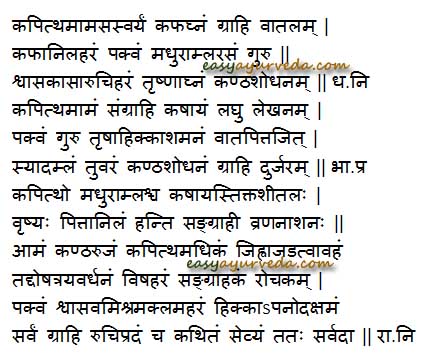
Side effects
Side effects of Wood Apple:
Ripened fruit is heavy for digestion and intake in excess quantity can lead to decreased digestive capacity. Similarly unripe fruit can cause hyperacidity if taken in excess quantity.
Unripe fruit is not ideal in case of throat / voice disorders.
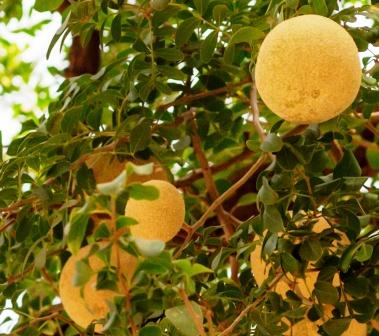
Interaction with medicines, supplements
Can this be used while taking Homeopathic medicine?
Yes. This product does not react with homeopathic medicine.
Can
this medicine be continued while taking supplements like multivitamin tablets,
Omega 3 fatty acids etc?
Yes. Generally, this product goes well with most
of the dietary supplements. However, if you are taking more than one product
per day, please consult your doctor for an opinion.
With western
medicines
Seek your
doctor’s advice if you are taking this product along with other western
(allopathic / modern) medicines. Some Ayurvedic herbs can interact with modern
medicine.
If both Ayurvedic and allopathic medicines are advised together, then it is
best to take Allopathic medicine first, wait for 30 minutes and then take the
Ayurvedic medicine.
Ayurvedic medicines
Medicines containing Kapittha – Elephant Apple:
Vajra kapat rasa: This is an Ayurvedic medicine in tablet form, used in the treatment of diarrhea, and mal absorption syndrome.
Nyagrodhadhi choorna: It is a medicine in powder form for the treatment of Urinary obstruction, Dysuria, urinary disorders, diabetes and its complications like Diabetic carbuncle.
Dashamoolarishta: It is used in the treatment of anemia, after delivery care of mother, cold, cough, digestive disorders etc.
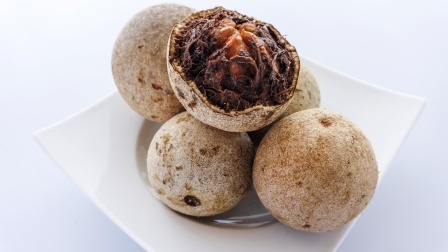
Research
Research articles related to Feronia limonia:
Neuro- protective action: We studied the effect of methanolic extract of F. limonia fruit (250 mg/kg, 500 mg/kg body weight, p.o.) and Vitamin E as reference standard drug on 30 min induced ischemia, followed by reperfusion by testing the neurobehavioral tests such as neurodeficit score, rota rod test, hanging wire test, beam walk test and elevated plus maze. The biochemical parameters, which were measured in animals brain were catalase, superoxide dismutase (SOD), malondialdehyde and nitric oxide in control and treated rats. The methanolic extract of F. limonia fruit (250 mg/kg, 500 mg/kg body weight, p.o.) treated groups showed a statistically significant improvement in the neurobehavioral parameters such as motor performance (neurological status, significant increase in grasping ability, forelimb strength improvement in balance and co-ordination). The biochemical parameters in the brains of rats showed a significant reduction in the total nitrite (P < 0.01) and lipid peroxidation (P < 0.01), also a significant enhanced activity of enzymatic antioxidants such as catalase (P < 0.01) and SOD (P < 0.05).
Anti- microbial action: The aim of present study was designed to investigate antibacterial & cytotoxic activities of the fruit pulp of the plants Feronia limonia (Linn) by using in vitro techniques. The antibacterial activity was determined by using disc diffusion method where ten pathogenic bacteria were used as test organisms. The extract displayed the moderate antibacterial action in terms of the diameter of the zone of inhibition.
Muscle relaxant property: In this study we evaluated the Muscle relaxant and anti-bacterial properties of the aqueous and ethanolic extracts of their leaves. The muscle relaxant activity was evaluated using rotarod method and actophotometer method. The results showed a significant reduction in the muscle coordination among the mice. Ethanolic extracts found to produce a better activity when compared to aqueous extract. Antibacterial activity was evaluated for 4 bacterial strains including 2 gram negative strains such as Pseudomonas aeruginosa, Escherichia coli and 2 gram positive strains such as Staphylococcus aureus, streptococcus faecalis.
Analgesic action: The study aimed to access the analgesic effect of Feronia limonia (FL, leaves of Feronia limonia (L.) Swingle). The leaves of FL were extracted with 95% ethanol and the dried extract (FLE) was administered intragastically (i.g.) at 100, 200 and 400 mg/kg. Analgesic effect was evaluated in two experimental animal models. In addition, single dose of FLE at 2g/kg body weight produce no observable acute toxicity in mice within seven days. These results demonstrate that FLE possess analgesic effects and has no obvious acute toxicity.
Hepato- protective action: The aim of this study was to evaluate the hepato-protective potential of a methanolic extract and of marmesin isolated from the root bark of Feronia limonia. In-vitro co-supplementation of F. limonia methanolic extract or marmesin significantly minimized alteration in levels of AST and ALT and improved cell viability. Oral administration of F. limonia methanolic extract or marmesin significantly prevented CCl4-induced elevation in the plasma markers of hepatic damage and hepatic lipid peroxidation and a decrease in hepatic antioxidants. In-vivo hepatoprotective potential of F. limonia methanolic extract and marmesin was evident from the minimal alterations in the histo-architecture of liver.
Classical categorization
Bhavaprakasha- Amradi phala varga
Dhanvantari Nighantu- Shatapuspadi varga
Kaiyyadeva Nighantu- Kritanna varga, Oushadhi varga
Raja Nighantu- Amradi varga
Scientific classification
Kingdom: Plantae
Order: Sapindales
Family: Rutaceae
Subfamily: Aurantioideae
Tribe: Citreae
Genus: Limonia L.
Species: L. acidissima
Author: Dr.B.K.Prashanth M.D (Ayu), Ph.D
E mail: [email protected]
Click to consult Dr Prashanth BK










